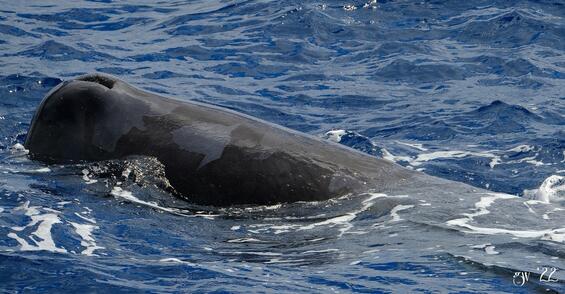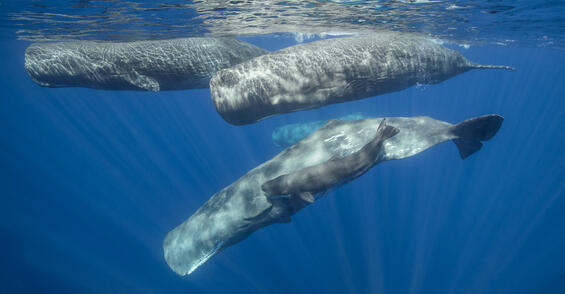- Scientific name: Physeter macrocephalus
- Species of Greatest Conservation Need (MA State Wildlife Action Plan)
- Endangered (MA Endangered Species Act)
- Endangered (US Endangered Species Act)
Description
The sperm whale is the largest of the toothed whales (NOAA 23025). They are dark grey but may have white patches on their bellies. Their head is prominent, as much as one third of their body, with a narrow lower jaw housing 20-26 teeth on each side. Sperm whales are suction feeders, so teeth are probably unnecessary for feeding as they do not break through the gums until after puberty and healthy sperm whales have been captured that do not possess any teeth. They have small flippers compared to the rest of their bodies and triangular tails (flukes). A distinguishing characteristic is the single blowhole that sits asymmetrically towards their left side. Adults have a large, overhanging rostrum that contains the spermaceti organ, an oil sac that helps whales focus sound. The sperm whale’s brain is the largest of any animal at 7.7 kg (17 lb) in mature males.
Sperm whales display a significant degree of sexual dimorphism, with adult males being about 1.5 times longer and 3 times heavier than females. Females usually reach about 12 m (40 ft) and 13.6 mt (15 tons). Males are now rarely greater than 16 m (52 ft) but can reach about 16 m (52 ft) and 1 mt (45 tons).
Life cycle and behavior
Sperm whales are a social species and often form units of adult females, their young, and juveniles of either gender. These stable, long-term matriarchal units often result in separation based on age and sex. Females reach sexual maturity at around 9 years of age and produce a calf at the rate of about one every five to seven years. There is a 14- to 16-month gestation period and females give birth to a single calf that can be up to 13 feet in length. Puberty in males is prolonged and may not be reached until the whale is 10 to 20 years old. A male may not actively participate in breeding until his late twenties. The lifespan of the sperm whale is not definitively known; however, females physically mature around 30 years of age while males mature at 50.
The sperm whale’s diet consists mainly of large squids, sharks, skates, and other fishes. The average dive for a sperm whale when capturing food lasts around 45 minutes, but they may dive for up to an hour and reach depths over 610 m (2000 ft).
Population status
Despite a significant population decline caused by commercial whaling in the nineteenth and twentieth century, sperm whales are found throughout all the deep oceans. Sperm whales seen off the Massachusetts coast belong to the North Atlantic stock. Studies found that females and juveniles of this stock show site fidelity and limited distribution, while males may migrate among other locations to feed and other populations to breed (NOAA 2023). Currently, this stock is made up by about 5900 individuals.
The few live sperm whales seen in New England have usually been very young calves, but two large adult males have washed up on Nantucket (T. French, pers. comm., MassWildlife). The first was a 14.3 m (47 ft) animal that stranded alive on Low Beach, Siasconset, on December 30, 1997. Its skeleton is now on display in the Nantucket Whaling Museum. The second was a 14 m (46 ft) 41 Mt (45 ton) whale that washed up on June 7, 2002, at Great Point. The skeleton of this animal is now on display in the New Bedford Whaling Museum.
Distribution and abundance
Sperm whales can be found in all the oceans of the world, but primarily in the higher latitudes from 45° north and south. Sperm whales generally inhabit deep water over 915 m (3000 ft) in depth and are uncommon in shallow waters. Young whales live in tropical waters all year. Though the sperm whale’s range depends on multiple variables such as locations of food sources, breeding condition, age, and sex, there is a general seasonal north-south movement of the species.
Shifts in migration
Like other whales, sperm whales appear to be shifting migration patterns due to climate change. From 2010 to 2017, the centroid of the sperm whale’s core range shifted 114 km (70 miles) in the spring, 202 km (126 miles) in the summer, 255 km (158 km) in the fall, and 71 km (44 miles) in the winter, all in a northeastern direction along the northeastern U.S. coast (Chavez-Rosales et al. 2022 in Staudinger et al. 2024).

Approximate range of the sperm whale (NOAA Fisheries)
Habitat

A sperm whale's blowhole is at the front of their head.
In New England, most sperm whales are generally found near the edge of the continental shelf, and beyond. During aerial surveys, sperm whales have also been sighted in shallower waters south of Martha’s Vineyard and Nantucket islands from August through November.
Healthy habitats are vital for supporting native wildlife and plants. Explore habitats and learn about conservation and restoration in Massachusetts.
Threats
As for other whales, sperm whales are threatened by vessel strikes, entanglement in fishing gear, pollution (i.e. plastic ingestion), and disturbance by anthropogenic noise which may be of particular concern for deep-diving species like sperm whales (NOAA 2023).

A pod of sperm whales.
Conservation
Several federal and state laws protect sperm whales including the Endangered Species Act, Massachusetts Endangered Species Act, and Marine Mammal Protection Act. In keeping with NOAA’s (2025) recovery planning, conservation efforts should focus on actions that:
- Reduce or eliminate injury or mortality caused by vessel collisions,
- Reduce or eliminate injury and mortality caused by fisheries and fishing gear,
- Protect habitats essential to the survival and recovery of the species,
- Minimize effects of vessel disturbance,
- Continue international ban on hunting and other directed take,
- Monitor the population size and trends in abundance,
- Maximize efforts to free entangled or stranded sperm whales, and
- Acquire scientific information from dead specimens.
The Massachusetts’s Division of Marine Fisheries (DMF) has worked hard to protect whales. More information on DMF’s is found at Conservation of Protected Marine Species | Mass.gov.
Stranded whales should be reported immediately to Marine Mammal Rescue and Research at 508-743-9548.
References
NOAA [National Oceanic and Atmospheric Administration]. 2025. Sperm Whale | NOAA Fisheries. Accessed on 6/23/25.
NOAA. 2023. Sperm whale (Physeter macrocephalus): North Atlantic stock. Available at: U.S. Atlantic and Gulf of Mexico Marine Mammal Stock Assessments 2023. Accessed on 6/23/25.
Contact
| Date published: | July 7, 2025 |
|---|

